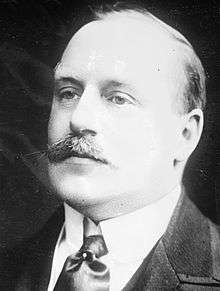Ormskirk was a county constituency represented in the House of Commons of the Parliament of the United Kingdom. It elected one Member of Parliament (MP) by the first past the post system of election. It was created by the Redistribution of Seats Act 1885 as a division of the parliamentary county of Lancashire. The constituency boundaries were changed in 1918, 1950, 1955 and 1974.[1]
Members of Parliament
History
The constituency was a Labour - Conservative marginal for much of its history, changing hands several times between the two parties during its 98-year existence.
The seat was initially a safe Conservative seat under the influence of the Stanleys, the Earls of Derby. Indeed the seat was held for twenty years by Arthur Stanley, a younger son of the 16th Earl. The only serious challenge by the Liberal Party in this period was in 1910 when William Lever, the leading industrialist, contested the seat. Indeed this was the last time the Liberal Party would contest the constituency until the 1970s.
James Bell became the first non Conservative to be elected for this seat since its creation in 1885, principally due to a divided conservative vote between the Coalition Conservatives and the candidate of the National Farmers Union at the 1918 General Election. Francis Blundell regained the seat for the Conservatives in 1922 but was to lose it to Labour's Sam Tom Rosbotham in 1929.
Sam Tom followed Ramsay MacDonald when the Labour Party split in 1931, and then defended the seat successfully for National Labour in both 1931 and 1935. He was succeeded in 1939 by Commander Stephen King-Hall for National Labour.
In a repeat of 1918, the election of 1945 saw future Prime Minister, Harold Wilson elected when the Conservative Party opted to stand against the National candidate, Stephen King-Hall, and split the anti Labour vote. With Harold Wilson moving in 1950 to the newly created Huyton constituency, the seat saw a succession of Conservative Members who were then moved on to the House of Lords, until the election of the much respected Colonel Douglas Glover in the 1953 by-election.
The retirement of Douglas Glover in 1970 saw the election of Harold Soref for the Conservatives who, however, was only to hold the seat for four years. Boundary changes brought in Kirkby New Town, leading to the election of Robert Kilroy-Silk for Labour.
The constituency ceased to exist with the implementation of the 1983 boundary changes. The sitting MP moved to the new Knowsley North seat.
Boundaries
1885–1918
The constituency, officially designated as South-West Lancashire, Ormskirk Division consisted of the town of Ormskirk and a number of surrounding parishes, namely:[1][2]
Aintree, Aughton, Bickerstaffe, Croxteth Park, Dalton, Downholland, Halsall, Kirkby, Knowsley, Lathom, Litherland, Lunt, Lydiate, Maghull, Melling, Netherton, Ormskirk, Orrell and Ford, Prescot, Scarisbrick, Sefton, Simonswood, Skelmersdale & Upholland.
1918–50
The Representation of the People Act 1918 reorganised constituencies throughout the United Kingdom. Boundaries were adjusted and seats were defined in terms of the districts created by the Local Government Act 1894. According to the schedules of the Act, the Lancashire, Ormskirk Division comprised:[3]
1950–55
The Representation of the People Act 1948 redistributed parliamentary seats, with the constituencies first being used in the general election of 1950. The term "county constituency" was introduced in place of "division". Ormskirk County Constituency was redefined as consisting of the following districts:[4]
- Formby Urban District
- Ormskirk Urban District
- Rainford Urban District
- West Lancashire Rural District (except the parishes of Aintree and Ford)
This reflected local government boundary changes in 1931/32: Lathom & Burscough UD had been absorbed by Ormskirk UD and Sefton RD by West Lancashire RD.[1]
1955–74
Following further council boundary changes in 1954, the remaining parishes from West Lancashire RD, (Aintree and Ford), were included in the constituency from 1955.[5]
1974–83
From 1970 the seat was again redefined, to cover the urban districts of Formby, Kirkby, Ormskirk and Rainford, and West Lancashire Rural District.[6]
Abolition
The constituency was abolished by the Parliamentary Constituencies (England) Order 1983, which redrew constituencies based on the new counties and districts created in 1974.
The Ormskirk area became part of West Lancashire, Kirkby was included in Knowsley North, Rainford in St Helens North and Formby, Aintree and Melling in Crosby.[7]
Election results
Elections in the 1970s
Elections in the 1960s
Elections in the 1950s
Elections in the 1940s
Elections in the 1930s
- Ormskirk by-election, 1939
In the Ormskirk By-Election of 27 October 1939, Stephen King-Hall, National Labour was elected unopposed.
Elections in the 1920s
Elections in the 1910s
- General election of December 1910
In the General Election December 1910, Arthur Stanley, Conservative was elected unopposed.
Elections in the 1900s

Arthur Stanley
- General election of 1900
In the United Kingdom general election, 1900, Arthur Stanley, Conservative was elected unopposed.
Elections in the 1890s
- Ormskirk by-election, 1898
In the Ormskirk By-Election of 20 October 1898, Arthur Stanley, Conservative was elected unopposed.
Elections in the 1880s
- General election of 1886
In the United Kingdom general election, 1886, Arthur Bower Forwood, Conservative was elected unopposed.
See also
Sources
References
- 1 2 3 Youngs, Guide to the Local Administrative Units of England, Volume 2
- ↑ Seventh Schedule: Counties at Large: Number of Members and Names and Contents of Divisions, Redistribution of Seats Act 1885, (1885 c.23)
- ↑ Ninth Schedule – Part II, Parliamentary Counties: England, excluding Monmouthshire, Representation of the People Act 1918 (1918 c.64)
- ↑ First Schedule: Parliamentary Constituencies, Representation of The People Act 1948, (1948 c.65)
- ↑ The Parliamentary Constituencies (Liverpool and South-West Lancashire) Order, 1955 (S.I. 1955 No. 15)
- ↑ The Parliamentary Constituencies (England) Order 1970 (S.I. 1970 No. 1674)
- ↑ Parliamentary Constituencies (England) Order 1983 (S.I. 1983 No. 417)
